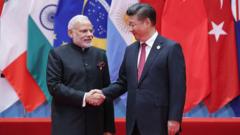Prada's alleged cultural appropriation of Kolhapuri sandals has sparked debate about the responsibilities of luxury brands while navigating India's unique artistic landscape. Experts emphasize the need for global fashion giants to engage with indigenous craftspeople respectfully, while industry insiders call for greater recognition and support for India's artisans.
Prada's Cultural Misstep: A Wake-Up Call for Luxury Brands in India

Prada's Cultural Misstep: A Wake-Up Call for Luxury Brands in India
Recent events surrounding Prada's Kolhapuri sandal controversy highlight the ongoing struggle of luxury brands in recognizing and respecting India's rich artistic heritage.
The iconic Kolhapuri sandals drew attention after Prada was accused of replicating the design, igniting conversations about the engagement of global luxury brands with India's rich artistic traditions. Sparked by an incident during Milan's fashion week in June, Prada's models showcased toe-braided sandals remarkably similar to the Kolhapuri chappal—a traditional handcrafted leather footwear originating from Kolhapur, Maharashtra. The apparent lack of acknowledgment regarding the sandals' roots led to widespread backlash, prompting the brand to later express openness for dialogue with local artisans.
In a recent turn of events, a Prada team met with Kolhapuri sandal makers and shopkeepers to grasp the craftsmanship and engage in dialogue about potential collaborations. This willingness to connect marks a notable instance of a global fashion powerhouse discerning the importance of local artisanship, an action rarely taken when addressing similar controversies.
However, this isn't an isolated case—numerous luxury brands have been scrutinized for pulling inspiration from Indian and South Asian cultures without proper credit. In 2023, both H&M and Reformation faced accusations of cultural appropriation for designs resembling South Asian traditional garments. Additionally, a recent collection by Dior received criticism for incorporating a distinctive Indian embroidery technique without recognizing its heritage.
Experts in the field assert not all global brands that draw inspiration from diverse cultures act with malicious intent; still, the responsibility to acknowledge these cultures is vital. Fashion industry insiders argue the need for brands to educate themselves on the significance of cultural respect, especially when market forces are incentivizing them to innovate through cultural motifs while pursuing profitability.
While India's luxury market is projected to experience significant growth—growing to $14 billion by 2032 due to an entering affluent middle class—many brands still perceive India merely as a production hub rather than a viable market. As Prada's case illustrates, the genuine oversight in recognizing local artisans leaves many luxury brands indifferent to the region's potential.
Fashion designer Anand Bhushan echoes a broader frustration regarding repeated missteps by luxury brands, which often fail to fully grasp or respect the historical context of the cultures they attempt to represent. Nonita Kalra, editor-in-chief of Tata CliQ Luxury, suggests that a younger demographic in India is reshaping luxury consumption, warranting brands to broaden their perspectives and include diverse voices in their design processes.
Furthermore, the outcry over Prada's apparent cultural insensitivity could serve as a catalyst for heightened accountability and respect for global traditions within the fashion industry, leading to more meaningful dialogue and collaborations. This situation also presents an opportunity for India itself to seek greater pride in its cultural legacy, ensuring the protection and fair compensation of its artisans who contribute to its vibrant tapestry of craftsmanship.
Laila Tyabji, chairperson of Dastkar, voice's concern about the ease with which foreign designers exploit Indian artisans, stressing the necessity for local appreciation and acknowledgment to combat potential exploitation. Recognizing and uplifting the rich heritage of crafts can simultaneously elevate artisans while fostering global partnerships that respect the origins of their artistry. As the luxury market continues to evolve, an engaged exchange between brands and local cultures may prove crucial for cultivating a mutually beneficial relationship that honors both artistry and commerce.




















